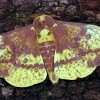Abstract
The imperial moth is one of our largest and most beautiful moths. It is also the most variable in appearance and the most widely distributed of our large eastern U.S. saturniid moths. This 9-page fact sheet was written by Donald W. Hall, and published by the UF Department of Entomology and Nematology, September 2014. (Photo: Donald W. Hall, University of Florida)
References
Arnaud PH. 1978. A Host-Parasite Catalog of North American Tachinidae (Diptera). United States Department of Agriculture Miscellaneous Publication 1319. Washington, D.C.
Beadle D, Leckie S. 2012. Petersen Field Guide to Moths of Northeastern North America. Houghton Mifflin. New York, N. Y. 611 pp.
Butterflies and Moths of North America. http://www.butterfliesandmoths.org/species/Eacles-imperialis
Covell CV. 2005. A Field Guide to Moths of Eastern North America. Special Publication Number 12. Virginia Museum of Natural History. Martinsville, Virginia. 496 pp.
Donahue RJ. 1965. Life cycle of seclusion. Natural History 74(5): 50-51.
Eliot IM, Soule CG. 1902. Caterpillars and their Moths. The Century Company, New York. 302 pp.
Ferguson DC. 1971. The Moths of North America. Fascicle 20.2A. Bombycoidea. Saturniidae (Part). Classey. Hampton, England. pp. 32-33.
Frank KD. 2006. Effects of artificial lighting on moths. In: Rich C, Longcore T. (ed.). Ecological consequences of artificial night lighting. Island Press. Washington, D.C. pp. 305-344.
Godfrey GL, Jeffords M, Appleby JE. 1987. Saturniidae (Bombycoidea). In Stehr FW. (ed.). Immature Insects. Kendall/Hunt Publishing Company. Dubuque, Iowa. pp. 513-521.
Goldstein PZ. 2003 (2010). Life history of the Imperial Moth . Journal of Research on the Lepidoptera 42: 34-49. https://doi.org/10.5962/p.266513
Heitzman JR, Heitzman JE. 1987. Butterflies and moths of Missouri. Missouri Department of Conservation. Jefferson City, Missouri. 385 pp.
Heppner JB. 2003. Lepidoptera of Florida. Part 1. Introduction and Catalog. Volume 17 of Arthropods of Florida and Neighboring Land Areas. Division of Plant Industry. Florida Department of Agriculture and Consumer Services. Gainesville, Florida. 670 pp.
Janzen DH, Hallwachs W, Harvey DJ, Darrow K, Rougerie R, Hajibabaei M, Smith MA, Bertrand C, Gamboa IC, Espinoza B, Sullivan JB, Decaens T, Herbin D, Chavarria LF, Franco R, Cambronero H, Rios S, Quesada F, Pereira G, Vargas J, Guadamuz A, Espinoza R, Hernandez J, Rios L, Cantillano E, Moraga R, Moraga C, Rios P, Rios M, Calero R, Martinez D, Briceño D, Carmona M, Apu E, Aragon K, Umaña C, Perez J, Cordoba A, Umaña P, Sihezar G, Espinoza O, Cano C, Araya E, Garcia D, Ramirez H, Pereira M, Cortez J, Pereira M, Medina W, Hebert PDN. 2012. What happens to the traditional taxonomy when a well-known tropical saturniid moth fauna is DNA barcoded? Invertebrate Systematics 26(5-6): 478-505. https://doi.org/10.1071/IS12038
Krombein KV, Hurd Jr.PD, Smith DR, Burks BD. 1979. Catalog of Hymenoptera in America North of Mexico. Volume 1. Symphyta and Apocrita (Parasitica). Smithsonian Institution Press. Washington, D.C. 1198 pp.
Lintner JA. 1869. Transformations of Eacles imperialis (Drury). Twenty-fourth report of the State Museum. XII. pp. 150-154. (From the twenty-third annual report of the New York State Cabinet of Natural History. Appendix D. Entomological Contributions.
Mosher E. 1914. The classification of the pupae of the Ceratocampidae and Hemileucidae. Annals of the Entomological Society of America 7(4): 277-300. https://doi.org/10.1093/aesa/7.4.277
Mosher E. 1916. A classification of the Lepidoptera based on characters of the pupae. Bulletin of the Illinois State Laboratory of Natural History 12:17-159. https://doi.org/10.21900/j.inhs.v12.348
North American Moth Photographers Group (Eacles imperialis page). http://mothphotographersgroup.msstate.edu/species.php?hodges=7704
Packard AS. 1893. The life histories of certain moths of the families Ceratocampidae, Hemileucidae, etc., with notes on the armature of the larvae. (pp. 157-163). Proceedings of the American Philosophical Society 31(141): 139-192.
Packard AS. 1905. Monograph of the bombycine moths of North America, including their transformations and origin of the larval markings and armature. Part 2. Family Ceratocampidae, subfamily Ceratocampinae. (pp. 119-126). Memoirs of the National Academy of Sciences Volume 9. 394 pp. + 57 plates. Available for free download here.
Plants Database. 2014. USDA Natural Resources Conservation Service. http://plants.usda.gov/java/
Peterson A. 1965. Some eggs of moths among the Sphingidae, Saturniidae, and Citheroniidae (Lepidoptera). Florida Entomologist 48: 213-219. https://doi.org/10.2307/3493773
Robinson GS, Ackery PR, Kitching IJ, Beccaloni GW, Hernández LM. HOSTS - a Database of the World's Lepidopteran Hostplants. (17 September 2014) https://doi.org/10.1111/ectj.12025
Rutkowski F. 1971. Notes on some south Florida Lepidoptera. Journal of the Lepidopterists' Society 25(2): 137-139.
Schmidt, MD. 1994. Eacles imperialis gender markings. Ohio Lepidopterist 16(4): 85.
Smith JE. 1797. The Natural History of the Rarser Lepidopterous Insects of Georgia. Vol. 2, Printed by Bensley T for Smith JE. London. 214 pp.
Soule CG. 1902. The hatching of Eacles imperialis. Psyche 9: 299-300. https://doi.org/10.1155/1902/85923
Stratton-Porter G. 1921. Moths of the Limberlost. Doubleday, Page, & Company. Garden City, New Jersey. 369 pp.
Tietz HM. 1972. An Index to the Described Life Histories, Early Stages and Hosts of the Macrolepidoptera of the Continental United States and Canada. Part 1. The Allyn Museum of Entomology. Sarasota, Florida. (Distributed by Entomological Reprint Specialists. Los Angeles, California). 536 pp.
Tuskes PM, Tuttle JP, Collins MM. 1996. The Wild Silk Moths of North America. Cornell University Press. Ithaca, NY. 250 pp. https://doi.org/10.7591/9781501738005
Villiard P. 1975. Moths and How to Rear Them. Dover Publications, Inc. New York, New York. 242 pp.
Wagner DL. 2005. Caterpillars of Eastern North America. Princeton University Press. Princeton, New Jersey. 512 pp.
Williams C. 1939. An analysis of four years of light trap captures of insects in a light trap. Part 1. General survey; sex proportion; phenology; and time of flight. The Transactions of the Royal Entomological Society of London 89(6): 79-131. https://doi.org/10.1111/j.1365-2311.1939.tb00738.x
Worth CB. 1980. An elegant harness for tethering large moths. Journal of the Lepidopterists' Society 34(1): 61-63.
Worth CB, Muller J. 1979. Captures of large moths by an UV light trap. Journal of the Lepidopterists' Society 33: 261-264.

